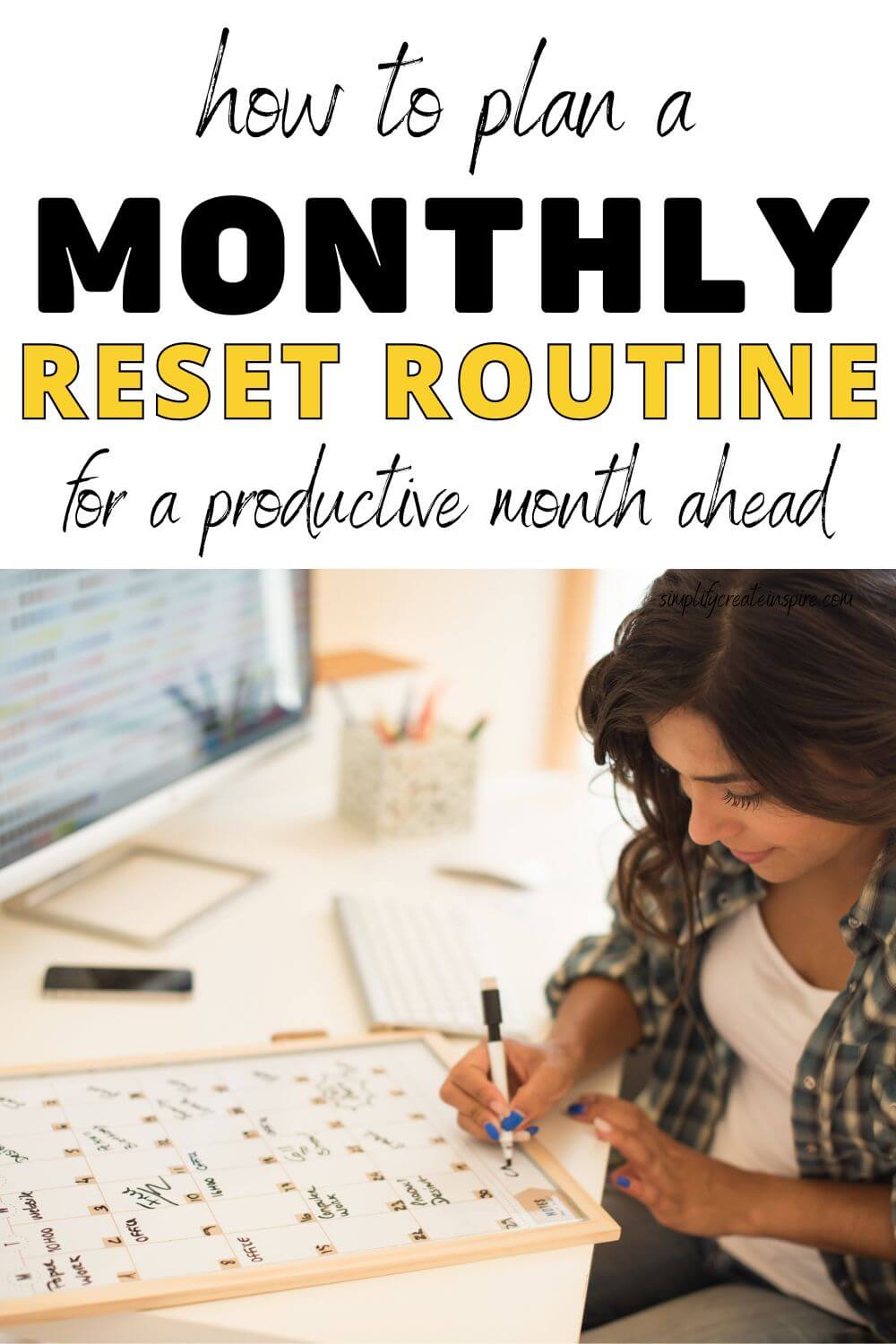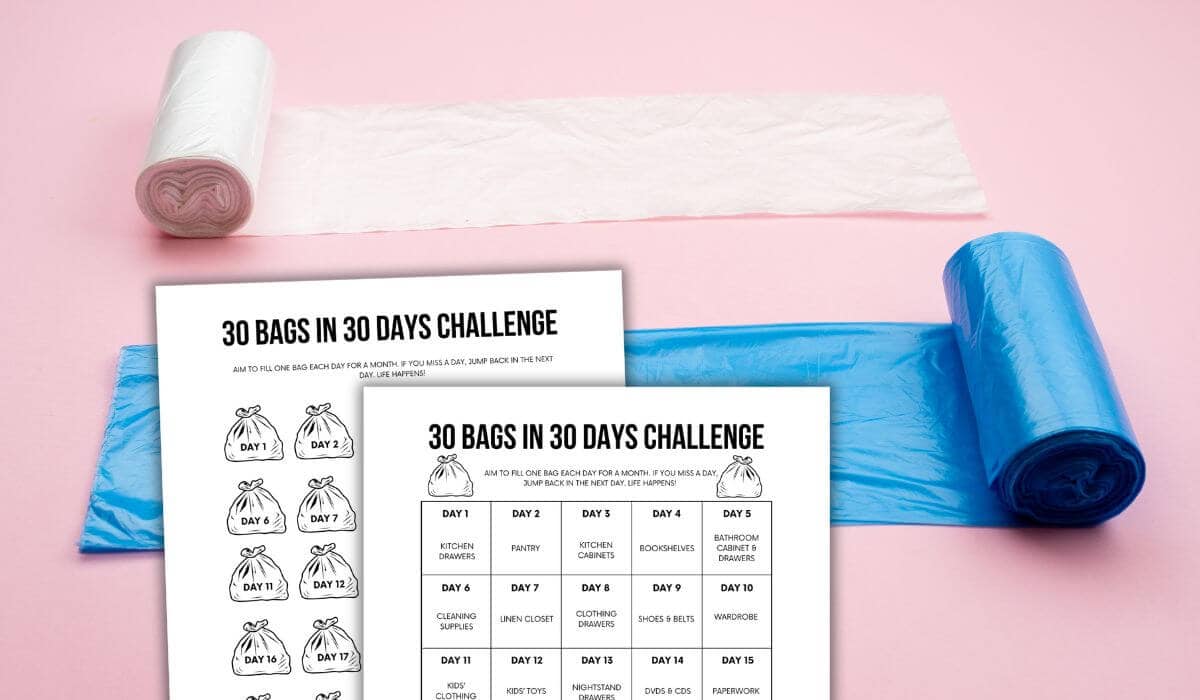How to Create a Monthly Reset Routine That Works
This post may contain affiliate links. Read the full disclosure
There’s something so exciting about starting fresh every month. It’s a time to let go of what no longer serves you and focus on what you want to achieve in the coming weeks. That’s why creating a monthly reset routine is about to become your new favourite tool to help you stay focused and motivated throughout the year.
In this guide, we will explore what a monthly reset is, why you should start a monthly reset routine, and provide a monthly reset checklist to help you get started.
Additionally, it will highlight the importance of weekly reflection questions and share some tips on how to incorporate them into your weekly routine.
What Is A Monthly Reset?

A monthly reset is a practice that involves taking some time at the end of every month to reflect on the previous month and set intentions for the new month.
This monthly routine is a time to evaluate your progress in different areas of your life, celebrate your accomplishments, and identify areas for improvement.
You can do your monthly routine either at the beginning of every month, as you prepare to kick off with a fresh start with new goals or you can do it towards the end of the month instead, as you wrap things up and prepare to flip over your calendar.
A monthly reset routine involves a chance for reflection and review of personal short and long-term goals, so you can see what worked and what didn’t, before preparing for a productive month ahead.
Why Should You Start A Monthly Reset Routine?
If you are someone who loves to kick off a new month with a clean slate, with brand new intentions and clear monthly goals in mind, then a monthly reset simply makes sense!
A monthly reset routine allows you to assess your progress and make any necessary adjustments to your goals and areas of your life that may not have gone as hoped during the last month.
It also gives you a chance to celebrate your achievements, no matter how big or small they may be.
Moreover, by setting aside time for reflection and intention-setting every month, you will become more mindful of your actions and decisions, leading to an increased sense of purpose and productivity.
But don’t think that a monthly reset is just for someone who is career or study-focused. A monthly reset is equally important for a happy household!
Your monthly reset may be more focused on resetting your home, identifying new habits to start and making sure you’ve planned self-care activities to nurture your well-being!
The best monthly reset routine includes a little from all those life areas!
Here are some of the main benefits of having your own monthly reset habit:
- Mental Clarity: Reflecting and resetting lets you declutter your mind, providing a fresh start for the upcoming month, and allowing you to leave the past month behind you.
- Goal Accomplishment: Regular reflection and intention-setting improves your readiness to make your goals a reality, by helping you identify the monthly tasks and habits you need to achieve them.
- Enhanced Productivity: A consistent practice of reflection and goal setting helps you stay organised and focused, thereby boosting productivity.
- Improved Well-Being: It allows you to prioritise your self-care, and physical and mental health, leading to a happier and healthier life.
- Increased Motivation: Regularly reviewing your progress and celebrating your accomplishments can help fuel your motivation to keep striving towards your goals.
Monthly Reset Checklist
Your perfect monthly reset routine will differ for each person, depending on the type of priorities you have and the areas of your life you are focused on.
In fact, it might change from month to month, depending on what you need at that time.
Use this step-by-step monthly reset checklist to get you started and adapt as needed to suit your own end-of-month needs and goals:
1. Past Month Reflection
The very first step of any monthly reset is reflection. Start by taking time to reflect on the past month – both the good and the bad.
You can use journaling prompts or monthly reflection questions to guide this process. Here are some examples:
- What were my biggest accomplishments last month?
- How did I take care of myself physically, mentally, and emotionally?
- What lessons did I learn last month?
- Did I make progress towards my goals?
- What went well last month?
- What could I have done better?
- What setbacks or roadblocks got in the way?
- Did I nurture the relationships that are important to me?
Using reflection questions or monthly reset journal prompts is a great way to gain insight into your patterns, habits, and behaviours. This can help you identify areas where you may need to make changes or improvements in the upcoming month.
As an alternative, you can also try using a rating system that lists each of the different areas of your life, including health, relationships, career, finances, and personal growth. Rate each area on a scale of 1-10 to get an overall view of how things are going in your life over the last 4 weeks.
2. Do A Brain Dump
After reflecting on the past month, it’s time to clear your mind and do a “brain dump.” This is simply taking all of the thoughts, ideas, tasks, and responsibilities swirling around in your head and putting them down on paper or digitally.
I like to do this in a to-do list format when I brain dump, but many people prefer to do a free-journaling exercise instead and write whatever comes to mind.
The purpose of a brain dump is to help you unload everything weighing on your mind so that you can focus on what’s important.
A brain dump is much like a deep cleaning for your brain!
Once you have everything written down, review the list and identify what needs to get done in the upcoming month. You will need this for the next steps of your monthly reset routine checklist.
3. Update Your Calendar
Using either a calendar or planner, digital or paper-based, depending on how you like to plan your time, make sure you have updated for the new month.
This means adding in all the non-negotiables such as appointments, work deadlines, events, and social commitments.
This visual representation of your month will help you assess how busy your schedule is so that you can set realistic expectations for what you want to achieve in the next month.
I have a personal calendar as well as a family view Google Calendar that both myself and my husband can update.
4. Goal Review and Setting
Next, it’s time to review your goals from the previous month and set new ones for the upcoming month. This is where you can assess your progress and make any necessary adjustments.
Celebrate any achievements and identify any areas that need improvement.
Use this to set SMART (specific, measurable, achievable, relevant, and time-bound) goals for the upcoming month.
You may like to have yearly goals, monthly goals and weekly goals – whatever works best for you!
If you find goal setting to be a tricky process, an alternative perspective that I love is focusing more on is setting intentions, and then identifying the habits that will help you achieve those intentions.
Make sure when you set goals that the number of goals is realistic.
Atomic Habits by James Clear is a brilliant book on the power of habits and you can find a list of habits to track here if you need more ideas.
5. Set Up Your Planner

Once you have your goals or intentions set for the month, it’s time to plan out your days and weeks.
This is where a planner comes in handy.
If you prefer digital planning, there are many apps and programs available that can help you organise and plan your tasks.
This is where you can set up your to-do lists, print off habit trackers, set reminders and pick a monthly affirmation.
6. Review Personal Finances
It’s important to regularly review your personal finances to ensure you are on track with your budget and financial goals.
This may include checking bank statements, reviewing expenses and income, and making any necessary adjustments.
You can also use this time to plan for upcoming bills or unexpected expenses. Make sure to add any of the expenses you are aware of to your planner so there are no unpleasant surprises.
PREPARE YOUR FAMILY BUDGET, SAVE MONEY & GET DEBT-FREE WITH MY BUDGET PLANNER

7. Meal Planning
Meal planning is a great way to save time and money, while also helping you to eat healthier.
Take some time at the beginning of each month to plan out your meals for the upcoming weeks. Using weekly meal theme nights such as Meatless Monday or Taco Tuesday can make this process easier.
This can also help with creating a grocery list and sticking to a budget when shopping.
You may prefer to meal plan in weekly blocks as part of a Sunday reset routine instead, however, your monthly reset is a good time to review what ingredients you already have in your home so you can make a plan to use these first.
Make a list of the items in your fridge, pantry and freezer to see what meals you can already make or if there’s essential ingredients to add to your shopping list.
8. Organise & Declutter
While you’re not exactly going to do a full home declutter at the end of every month, taking a few moments to tidy up and organise your physical space can help you feel more productive and focused.
Make sure to file away any important documents, clear off your desk or workspace, and get rid of any unnecessary clutter.
This will not only make it easier to find things when you need them but also create a more pleasant environment for you to live and work in.
Do a kitchen reset and a quick tidy up, putting obvious items in their correct place and putting away piles of laundry. It’s amazing how good it feels to include these steps as part of your monthly reset routine!
A digital declutter is also a great way to start a fresh month with an organised digital space.
One of my monthly reset habits is inbox zero, deleting unwanted emails (and unsubscribing to any I no longer read), actioning others and filing the rest.
When Should You Do A Monthly Reset?
While a monthly reset is a personal practice, I recommend doing it on the last day of the month so you are ready to hit the ground running on the 1st of the month.
If this doesn’t work for you, the beginning of the month is also a great option that allows you to start fresh with a clear mind and a plan for the coming weeks.
But sometimes life happens and things don’t go to plan so it’s okay to adjust when you do your reset routine to suit!
If you’re prone to forgetting, you can set yourself a reminder at the end of each month with a list of things you want to incorporate – your own personal monthly reset checklist.
Creating a monthly reset routine is an excellent way to stay focused and motivated throughout the year. Incorporating weekly reflection questions can help you evaluate your progress and make adjustments as needed. Remember, a monthly reset is a personal practice, so make sure you find a routine that works best for you. By creating a monthly reset routine checklist and committing to it, you will be well on your way to achieving your goals and living your best life.







